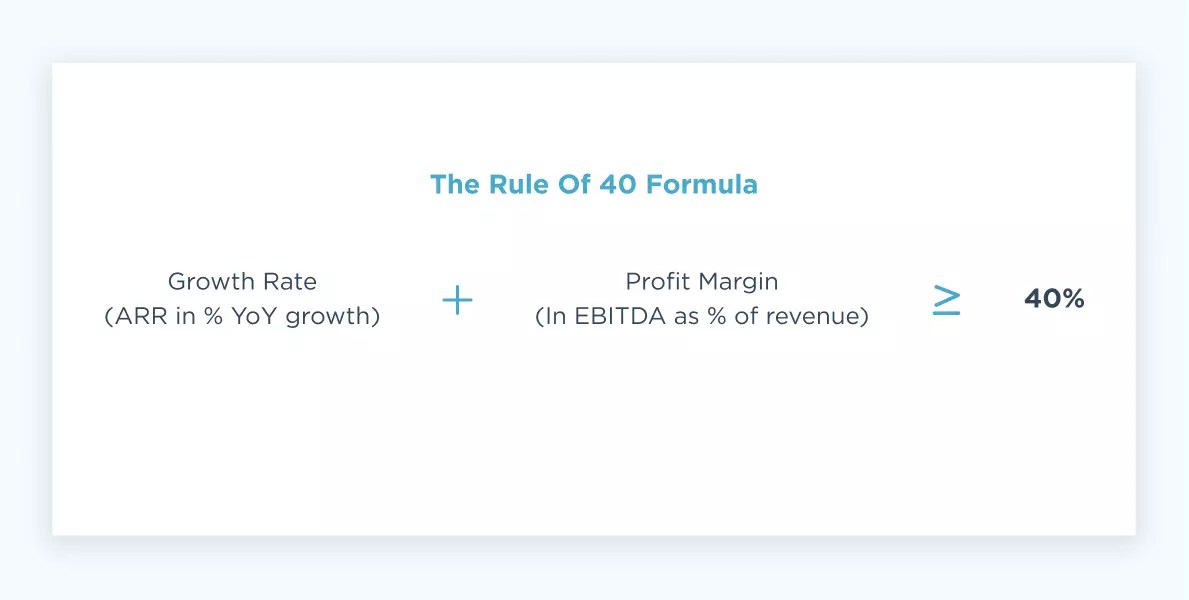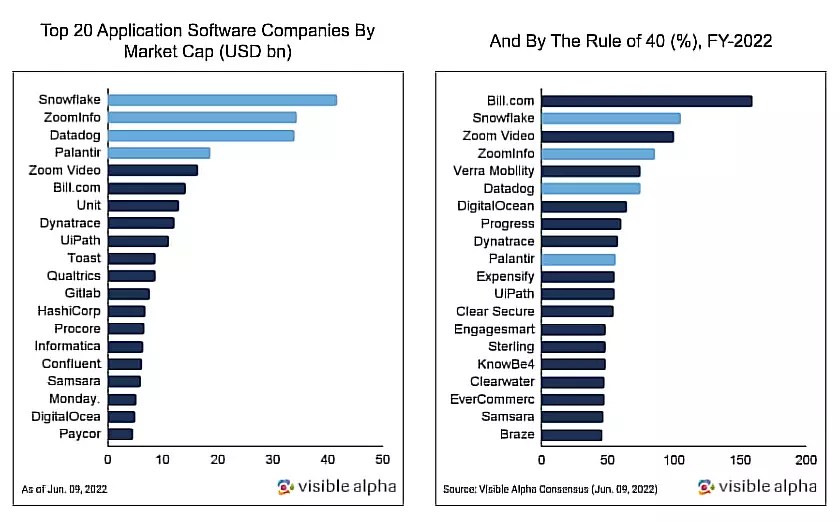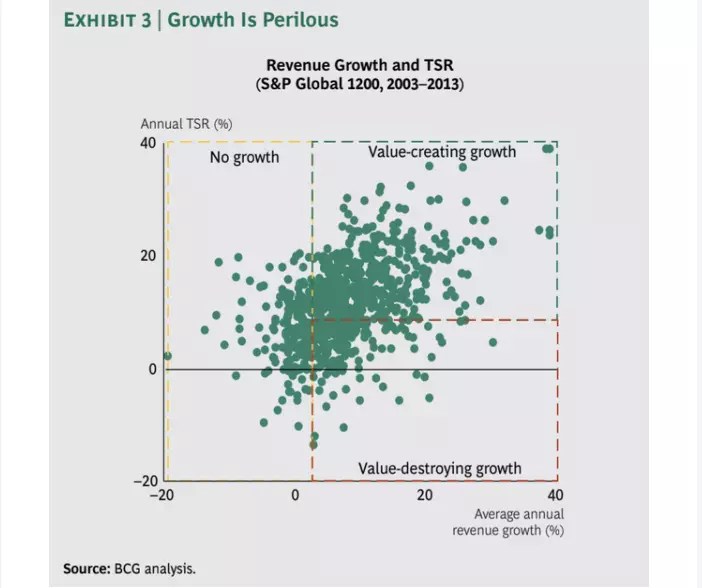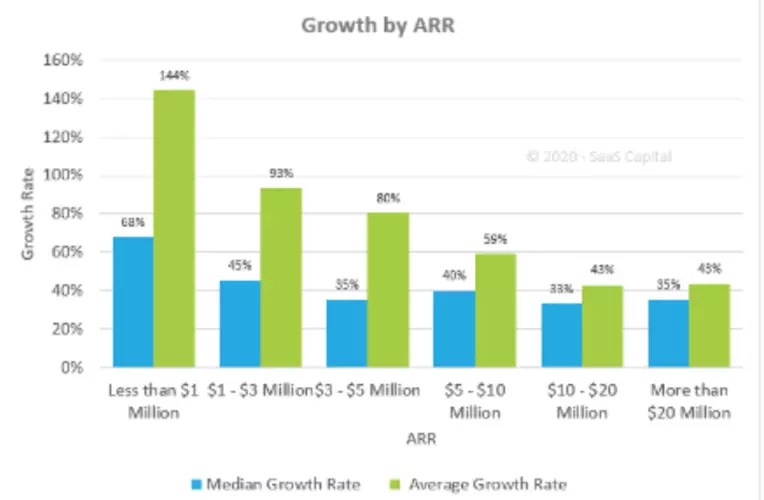Many SaaS businesses emphasize customer acquisition and retention over growing gross margins, especially during the startup and scale-up stages. It makes sense.
A company can grow its revenue faster if it acquires and retains more buying customers as opposed to simply selling more to existing customers.
Yet, here’s the thing. Revenue growth measures the increase in the amount of money a business takes in from sales. Gross margin growth determines how much profit the business is actually making after deducting the cost of goods sold (COGS), expenses, and taxes.
So, how can you tell if your SaaS company is growing sustainably? And how do you know when to focus on improving profitability — rather than just capturing a larger market share or ARR? Enter the Rule of 40 for SaaS companies.
Table Of Contents
- What Is The Rule Of 40?
- Measuring Growth Rate And Profitability
- The Rule Of 40 Formula
- How To Calculate The Rule Of 40 (Example)
- How Many SaaS Companies Exceed The Rule Of 40?
- Why Use The Rule Of 40? Here Are 4 Crucial Benefits
- When To Use The Rule Of 40
- What Is A Good SaaS Growth Rate?
- Balancing Competing Goals
- Take Benchmarks With A Grain Of Salt
What Is The Rule Of 40?
The Rule of 40 is a principle that states a software company’s combined revenue growth rate and profit margin should equal or exceed 40%. SaaS companies above 40% are generating profit at a rate that’s sustainable, whereas companies below 40% may face cash flow or liquidity issues.
Naturally, to determine whether the company is above 40% or below, it must know two things:
- Revenue growth
- Profitability margin
The Rule of 40 does not apply across every industry (it is specific to SaaS companies), but it is still a handy benchmark. This is because the SaaS sector manages high margins of 70%-90%, making the rule applicable to them compared to other subscription-based companies or otherwise.
Again, the primary purpose of benchmarking is to make it easier to compare companies that have different operating structures, are at different phases of the business cycle, or are otherwise difficult to compare.

Measuring Growth Rate And Profitability
Calculating revenue growth should be easy for any SaaS company operating for at least a year. The Generally Accepted Accounting Principles (GAAP) establish clear definitions for what constitutes revenue, and these definitions tend to remain consistent year over year.
Keeping this in mind: your business should be able to quickly look at the revenue column on your most recent income statements and calculate your annualized revenue change.
On the other hand, “profitability margin” is a rather broad term that can potentially be used to describe several different items on your company’s balance sheet or income statement.
A few of these possible items might include free cash flow (meaning you might need to create a statement of cash flows), total operating income, and earnings before interest, taxes, debt, and appreciation (EBITDA).
If using EBITDA, calculate profitability margin by measuring EBITDA as a percentage of total operating revenue (mentioned above).
The Rule Of 40 Formula
Using the Rule of 40: SaaS Growth Rate plus Profit Margin should be equal to or greater than 40%:
SaaS Growth Rate + SaaS Profit Margin > 40%
But it’s not quite there yet. It depends on how you calculate your revenue growth and profit margin.
A company’s revenue growth rate is typically measured by its monthly recurring revenue (MRR) or annual recurring revenue (ARR).
Monthly Recurring Revenue (MRR) = The Total Number of Active Accounts X Average Revenue Per Account (ARPA)
Annual Recurring Revenue (ARR) = MRR × 12 months
Growth Rate = (Current Year Value – Prior Year Value) ÷ Prior Year Value
When it comes to profit margin, the most commonly used metric is the EBITDA margin for the corresponding period.
EBITDA Margin (%) = EBITDA ÷ Revenue
Using this approach, the correct formula for calculating The Rule of 40 is:

There is some debate about at what funding stage the rule should be applied (or less so), and its reliability as a metric. Yet, its simplicity and accuracy make the Rule of 40 popular.
“Annual Recurring Revenue is the North Star but expanding your margins is how you win”
How To Calculate The Rule Of 40 (Example)
Let’s look at a simplified Rule of 40 example.
If a company generated 10 million USD in revenue in 2019 and 12 million USD in revenue in 2020, then its year-over-year revenue growth would equal 20% (2 million divided by 10 million then multiplied by 100%).
Suppose the same company is using EBITDA as its primary “profitability” metric and that its EBITDA for 2020 was 3 million USD. In this case, the profitability margin for the company would be 30% (3 million divided by 10 million).
In this example, the company’s revenue growth plus profitability margin would equal 50% (20% plus 30%). This means that the company has “passed” the Rule of 40 and is likely well-positioned for the future.
Revenue growth and profitability margin could be negative, especially if the company has recently accrued significant amounts of debt or significant capital expenses.
However, even when either of these figures is, in fact, negative, the company can still utilize the Rule of 40 and hope that success in one area could offset any issues created by the other.
How Many SaaS Companies Exceed The Rule Of 40?
In 2017, about 40% of SaaS companies achieved The Rule of 40, according to Bain and Company.

Credit: Number of SaaS companies that passed the Rule of 40 in 2017
In 2021, data from the KeyBanc Capital Markets (KBCM) 2021 SaaS Survey indicated that 50 out of 175 SaaS companies with more than $5 million Annual Recurring Revenue met the Rule of 40, which translates to 29% of the companies.

Credit: Number of SaaS companies in 2021 that exceeded the Rule of 40 – KBCM data
More recently in 2022, a Visible Alpha analysis concluded that the most well-known or largest firms in SaaS don’t always have the best outlook based on the Rule of 40.

Credit: Largest SaaS companies vs SaaS companies that exceed the Rule of 40 – Visible Alpha
Why Use The Rule of 40? Here Are 4 Crucial Benefits
Benchmarking, balancing profitability and growth, as well as informing long-term and short-term decisions are some examples of the uses of the Rule of 40 for SaaS businesses. Here are more details.
1. The Rule of 40 offers a guide to what tradeoffs a SaaS company can afford
You are running a healthy SaaS business if you manage a 20% growth rate with a 20% profit margin. You can operate at a 10% loss if you achieve a 50% growth rate. You are also on the right track if you reach 40% growth with 0% profit and vice versa.
But suppose growth and profitability fall below 40%. In that case, you’ll want to inspect your other SaaS metrics to identify any potential issues, such as increased cost of goods sold (COGS), Customer Acquisition Cost (CAC), Churn, and more.
2. It helps assess your ability to invest without sacrificing profit
Profitability and growth rates over 40% suggest you have room to pursue hypergrowth to gain and retain more customers. A move like that can help sustain the company’s “beyond 40” performance over a more extended period.
Sustaining profitability and revenue growth at 20% each can be challenging, as you may easily remain in sub-scale mode for longer than necessary. A competitive market demands that you capture and hold the largest possible share of your targeted market as soon as possible.
Yet, you might need investors to fund that hypergrowth mode. This brings us to one of the biggest reasons for calculating the Rule of 40.
3. Investors use the Rule of 40 to compare high-quality SaaS investment opportunities
VCs came up with the Rule of 40, after all. It is a way to quantify a SaaS company’s potential for creating value for them as it grows — regardless of whether it is yet profitable.
SaaS companies often reach high valuations, sometimes too high. But as investors consider valuation for short-term plans, they are aware that some SaaS companies destroy their value as their average annual revenue grows.

Credit: Value-creating vs. value-destroying growth analysis by Boston Consulting Group
The Rule of 40 does not take valuation into account. The approach focuses on measuring sustained value creation instead, which helps evaluate SaaS investment opportunities.
4. You can use the Rule of 40 to determine when to maximize growth or profitability at any given stage
In the SaaS sector, it is assumed that startups and smaller SaaS businesses should focus on growing revenue, even if they don’t make a profit. This is not always the case.
If you are going to justify a runaway growth rate with a skin-deep margin, you need to be able to say: “we can turn a profit right away if we slow down our growth rate”.
Still, the Rule of 40 can help mature SaaS businesses that have captured most of their attainable market share to focus more on margin growth than worry about expansion. After all, most SaaS companies see their growth rate decline over time.
Small companies can also use this metric to focus on marketing and sales tactics that attract and keep customers while yielding high enough margins to appeal to investors who can fund their growth.
When To Use The Rule Of 40: Should You Measure The Rule Of 40 As A Startup?
The Rule of 40 initially applied when a SaaS business exceeded $50 million in annual revenue. Those who pioneered the rule, including Brad Feld, recommend applying it to your company if you’ve reached $1 million in annual recurring revenue.
According to a SaaS Capital survey, many SaaS companies reach $1 million in ARR in about five years. However, assessing a 12-18 months’ period can help you see an accurate SaaS growth curve as a younger company.
Alternatively, you can wait until you have put most departments in place, have figured out your product-market fit, and sorted out cash flow issues.
Still, as with any other SaaS value metric, use the Rule of 40 as part of your overall health assessment, not as the sole metric.
What Is A Good SaaS Growth Rate?
On average, SaaS revenue growth ranges from 15% to 45% year to year. But SaaS growth rate also varies widely based on a company’s development stage. The growth rate of companies with less than $2 million in revenue is often higher than that of companies with more than that.
Take a look at this SaaS Capital chart:

Credit: SaaS Capital
Note:
- Using the chart, you can compare your SaaS growth rate with other similar SaaS companies.
- Growth and company age are inversely related. The growth rate of SaaS companies over 12 years is typically 20%.
So, what happens after calculating your 40% rule?
Balancing Competing Goals
Ultimately, running a business — whether in the SaaS industry or any other — is going to involve making some critical tradeoffs. One typical tradeoff is that pursuing additional revenue streams will often (at least temporarily) eat into a company’s profit margin.
Pursuing revenue-generating activities, such as reaching a wider audience, expanding a product line, or enhancing a product via additional research and development, will introduce additional expenses that can eat at marginal profitability.
At the same time, finding ways to improve profit margins — such as cutting the marketing budget—can cause revenue to decline.
This is all okay and normal.
The management team’s role is to carefully balance both competing interests at once and think about the company’s long-term financial plan. The Rule of 40 is so useful because it allows managers to consider how each of these metrics relates to one another while still ensuring the company is at least making some type of progress.
Pursuing revenue growth and managing profit margins will be a vital component of running a SaaS business. The main point of emphasis here is that your business should be actively pursuing and enhancing at least one of these goals at a time.
Benchmarks With A Grain Of Salt
While the Rule of 40 is undoubtedly something that can benefit many SaaS enterprises, it is also something that should be taken with a grain of salt.
There are plenty of companies above 40 that still have other financial issues and plenty below 40 that are doing quite well. Furthermore, the unusual economic year we witnessed in 2020 will inevitably cause some benchmarks to be less useful than usual.
Still, even keeping these things in mind, the Rule of 40 has become quite popular throughout the broader SaaS industry. When combined with other valuable metrics, it can help managers make decisions truly best for their business.
Looking To Control Your Profit Margin And Achieve The Rule of 40?
Cloud infrastructure costs contribute significantly to the operating costs of many SaaS companies. Another important aspect is keeping your company’s cost of goods sold (COGS) in excellent correlation with its recurring revenue growth rate.
Yet getting a better understanding of how your costs relate to your key business metrics, like cost per feature, cost per customer, and cost per team, can be difficult. But CloudZero can help.
- Your engineers can leverage cloud cost intelligence to understand cost per product feature, cost per deployment, or cost per dev team.
- CloudZero helps finance departments set the right SaaS pricing to increase revenue growth and profitability by measuring and reporting actionable unit economics, such as cost per customer.
- As the company develops, executives and investors can use CloudZero to analyze their gross margins and decide what tradeoffs to make to boost growth, profitability, or investor appeal.
 to see how you can leverage the Rule of 40 like a late-stage investor.
to see how you can leverage the Rule of 40 like a late-stage investor.

Author: Cody Slingerland
Cody Slingerland, a FinOps certified practitioner, is an avid content creator with over 10 years of experience creating content for SaaS and technology companies. Cody collaborates with internal team members and subject matter experts to create expert-written content on the CloudZero blog.
